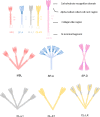A Plausible Role for Collectins in Skin Immune Homeostasis
- PMID: 33790889
- PMCID: PMC8006919
- DOI: 10.3389/fimmu.2021.594858
A Plausible Role for Collectins in Skin Immune Homeostasis
Abstract
The skin is a complex organ that faces the external environment and participates in the innate immune system. Skin immune homeostasis is necessary to defend against external microorganisms and to recover from stress to the skin. This homeostasis depends on interactions among a variety of cells, cytokines, and the complement system. Collectins belong to the lectin pathway of the complement system, and have various roles in innate immune responses. Mannose-binding lectin (MBL), collectin kidney 1, and liver (CL-K1, CL-L1) activate the lectin pathway, while all have multiple functions, including recognition of pathogens, opsonization of phagocytosis, and modulation of cytokine-mediated inflammatory responses. Certain collectins are localized in the skin, and their expressions change during skin diseases. In this review, we summarize important advances in our understanding of how MBL, surfactant proteins A and D, CL-L1, and CL-K1 function in skin immune homeostasis. Based on the potential roles of collectins in skin diseases, we suggest therapeutic strategies for skin diseases through the targeting of collectins and relevant regulators.
Keywords: collectins; immune homeostasis; immunity; immunotherapy; skin.
Copyright © 2021 Wang, Li, Xiao and Xia.
Conflict of interest statement
The authors declare that the research was conducted in the absence of any commercial or financial relationships that could be construed as a potential conflict of interest.
Figures






Similar articles
-
The collectins CL-L1, CL-K1 and CL-P1, and their roles in complement and innate immunity.Immunobiology. 2016 Oct;221(10):1058-67. doi: 10.1016/j.imbio.2016.05.012. Epub 2016 Jun 2. Immunobiology. 2016. PMID: 27377710 Review.
-
Structural and functional diversity of collectins and ficolins and their relationship to disease.Semin Immunopathol. 2018 Jan;40(1):75-85. doi: 10.1007/s00281-017-0642-0. Epub 2017 Sep 11. Semin Immunopathol. 2018. PMID: 28894916 Free PMC article. Review.
-
Structure and function of collectin liver 1 (CL-L1) and collectin 11 (CL-11, CL-K1).Immunobiology. 2012 Sep;217(9):851-63. doi: 10.1016/j.imbio.2011.12.008. Epub 2012 Feb 4. Immunobiology. 2012. PMID: 22475410 Review.
-
Collectin Kidney 1 Plays an Important Role in Innate Immunity against Streptococcus pneumoniae Infection.J Innate Immun. 2017;9(2):217-228. doi: 10.1159/000453316. Epub 2017 Jan 10. J Innate Immun. 2017. PMID: 28068663 Free PMC article.
-
Characterization of the interaction between collectin 11 (CL-11, CL-K1) and nucleic acids.Mol Immunol. 2013 Dec;56(4):757-67. doi: 10.1016/j.molimm.2013.07.011. Epub 2013 Aug 14. Mol Immunol. 2013. PMID: 23954398
Cited by
-
Bibliometric Study of Adaptogens in Dermatology: Pharmacophylogeny, Phytochemistry, and Pharmacological Mechanisms.Drug Des Devel Ther. 2023 Feb 6;17:341-361. doi: 10.2147/DDDT.S395256. eCollection 2023. Drug Des Devel Ther. 2023. PMID: 36776447 Free PMC article. Review.
References
Publication types
MeSH terms
Substances
LinkOut - more resources
Full Text Sources
Other Literature Sources
Miscellaneous

